Trip report for the Rottnest island weekend 10-12 December 2023
Ningaloo Dreaming – August 2021
Report by Jo Foley
After a stressful start due to vehicle issues (Jill get a Hyundai or Toyota12), we (Jo, Jill and Colin) finally made it to Coral Bay and celebrated with bubbly and hearing some fascinating stories about Colin’s past! Coral Bay was the starting point for our expedition to Tantabiddi Boat Ramp paddling inside the Ningaloo Reef, which is the largest fringing reef in the world stretching over 250kms and of which we were to paddle 165km’s of it. ‘Ningaloo’ comes from the Wajarri language meaning high land jutting into the sea and is home to over 450 species of marine life – large and small.
The following day involved a car shuffle where we dropped Colin’s car at Learmonth airport so when Gail flew up several days later, she could then drive up and meet us at Yardie Creek. This was a late change of plans as Gail was originally paddling with us (4 being the ideal number for the trip), however she hurt her shoulder so sensibly decided to fly up and camp out in Cape Range to have a bit of a holiday. My car was to be left at Coral Bay for 6 days.
Having done several day paddles over the years between Yardie Creek and Mangrove Bay, I had for many years dreamed of doing an expedition along Ningaloo Reef. Most club members who have done the trip have paddled between Ningaloo Station and Tantabiddi, but Colin suggested we paddle from Coral Bay as he and Gail had previously paddled from there. We thought that was a great idea, as with Parks taking over the management of Ningaloo Station camps, we weren’t sure of the logistics from there.
Day 1 (22/8/21) 18.5km
After packing up our kayaks, managing to squeeze in 30L of water, food for 6 days, camping equipment etc we headed off about 10:30am and the dream had now become reality!
We couldn’t have had a better start to the trip, with a high tide and a lovely following wind of at least 15knots SSE. We flew along not yet with sails as we were wanting to get a feel for our loaded kayaks. We had thought we might camp the night at Bateman Bay just south of where an extended rocky coastline begins which makes landing the kayaks difficult. However, with the wind assistance and due to a break in the reef allowing in 2m swell that was breaking on the beach we decided to push on. We popped up our sails and had an enjoyable ride passing dolphins, turtle and small rays before finding a perfect spot to camp about 3km south of Bruboodjoo Point. We had a bug free camp under a full moon.


Day 2 (23/8/21) 26 km
We woke up to dry tents and started our day the same way we would for the rest of the trip – with Colin being first up eating his porridge and Jill and I lazing in our tents, packing our gear and then squeezing it all into our kayaks. Without fail it seemed that we were ready to set off about 9:30am each morning. The thing that was different about today was we had a 15+knot NE then NW wind so a trying day paddling into what was mostly a headwind. We had a few turtles pop up to break the monotony of the slog. After nearly 6hrs we found an OK camp spot about 5km south of Jane Bay. My right wrist and shoulder were killing me, and this had made the day particularly challenging. Colin looked like an energiser bunny, always off in the distance, so I was secretly pleased when he admitted how tired he was. Needless to say, we were all tucked up in our beds by 7:30pm! During the night around high tide we could hear the waves crashing up on the beach so slept fitfully envisioning our kayaks drifting out to sea.
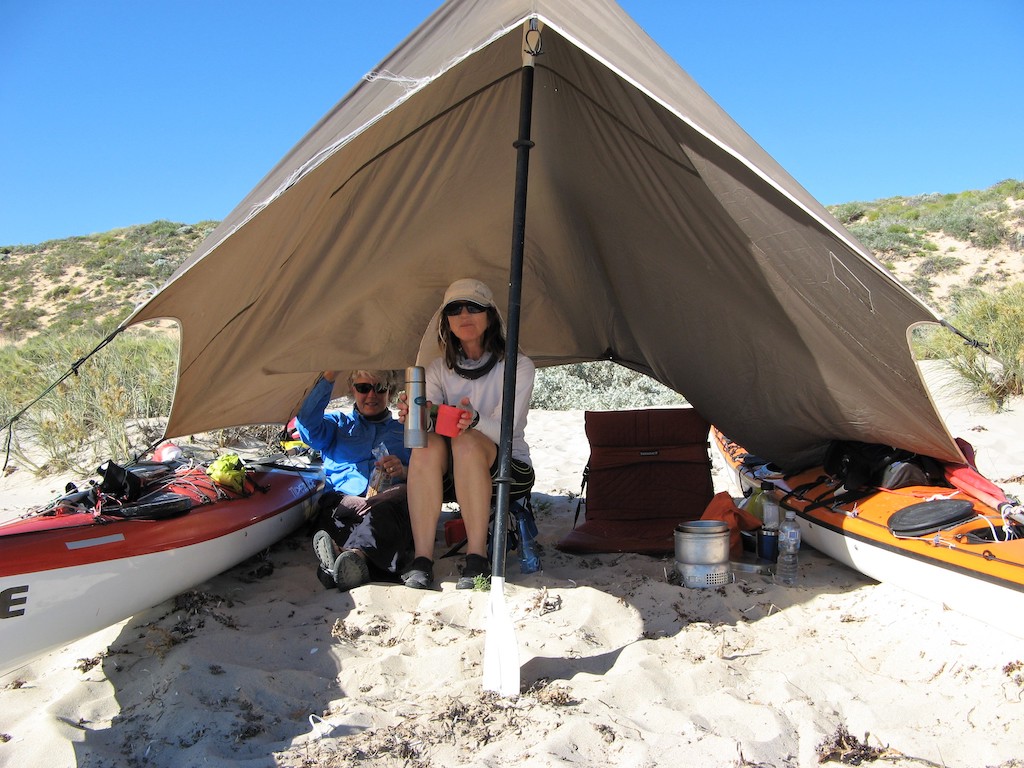
Day 3 (24/8/21) 26km
Fortunately, our kayaks were still there when we woke up and the winds, although from the north, were nice and light. This meant for soggy tents which we waited a while before packing them up. We paddled in 2+m rolling swell over shallow water, so if the wind had picked up, we would have been dodging breaking waves. As we rounded Point Cloates the reef comes in very close, so we found a confused sea with small breaking waves and had to paddle against the current. Passing the old lighthouse and Ningaloo Homestead we found ourselves paddling in a stunning glassy blue bay. Further north we hit shallow water and unpredictable small breaking waves due to a gap in the reef which occasionally slapped us in the face! Turtles and an osprey kept us company along the way. Finding a suitable place to camp for the night was proving difficult due to the sizeable swell breaking on the beach. At around 26km, still dodging the breaking waves, we found a gentler landing on a beach where we believed there were sand dunes for us to camp in. Unfortunately, they were full of thick scrub, but we were too lazy to paddle on further so squeezed our tents into small niches. We were unaware we were so close to a track until a vehicle drove past, but by that stage Jill and I had set up our tents so we decided we would take the risk and stay put. Now that the moon was waning we experienced incredible night skies for star gazing and viewing the milky way and the emu (aboriginal astronomical constellation outlined by the dark areas of the night sky).
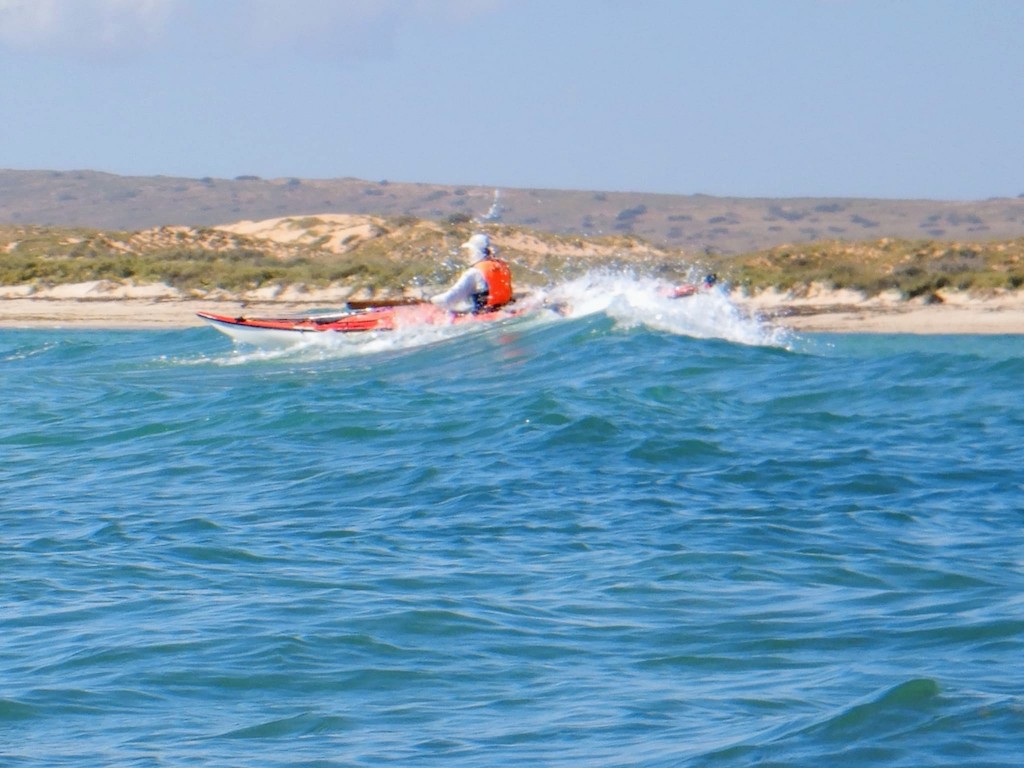
Day 4 (25/8/21) 16km
I got up about 7am to clear skies, but within minutes a mist cloaked the sea and land. Colin was sitting out having his breakfast and disappeared into the mist as we heard him say “this could be Scotland!” and I said it reminded me of the movie “an American Werewolf in London”. Jill who was still cuddled up in her sleeping bag had no idea what we were talking about until she popped her head out of the tent. While we waited for the mist to clear Jill decided to walk down the beach to see what a sign in the distance said. She was horrified to find that the sign warned of asbestos lagging in the area, hence we dubbed our camp spot ‘Asbestos Bay’. The lagging would have come from the Norwegian Bay whaling station about 2.5km to our north. We paddled there and had a look around. It was surprising to see how extensive the ruins were, with the rusted remains of oil holding tanks, boilers and machinery that was used to process whale oil between 1915 and 1957. Paddling on we rounded a cape and found more confused waves before continuing to the pretty bay at Point Billie. We pulled into the quicksand like shoreline for lunch. Jill was itching to snorkel until we saw lots of bluebottles washed up on the beach. With a 10 knot south westerly now in we had a fantastic sail through the stunning North Lefroy Bay which was framed by the backdrop of the Cape Range. Finding a fabulous spot to camp at the southern end of Winderbandie Point and having landed earlier than previous days, we had a swim / snorkel and hung our paddling clothes out to dry in the warm windy conditions. Colin, who hates to lose anything, was searching frantically for his Sea Kayak Fest Buff which he thought must have blown away. However, it was later found in Jill’s tent where she had squirreled it away! Jill and I had been cooking our meals together each night, never knowing what we might serve up for dinner, but always bulked up by Jill’s fabulous, dehydrated veggies. Colin on the other hand was a man of routine and had the same dinner of homemade dehydrated savoury mince each night, which he obviously enjoyed. What he likely didn’t enjoy was Jill and my ribbing when we would ask him every night “what he was having for dinner?” After dinner I entertained (or tortured) the others with my unusual yoga poses and then we laid back blissfully viewing the stunning night skies.
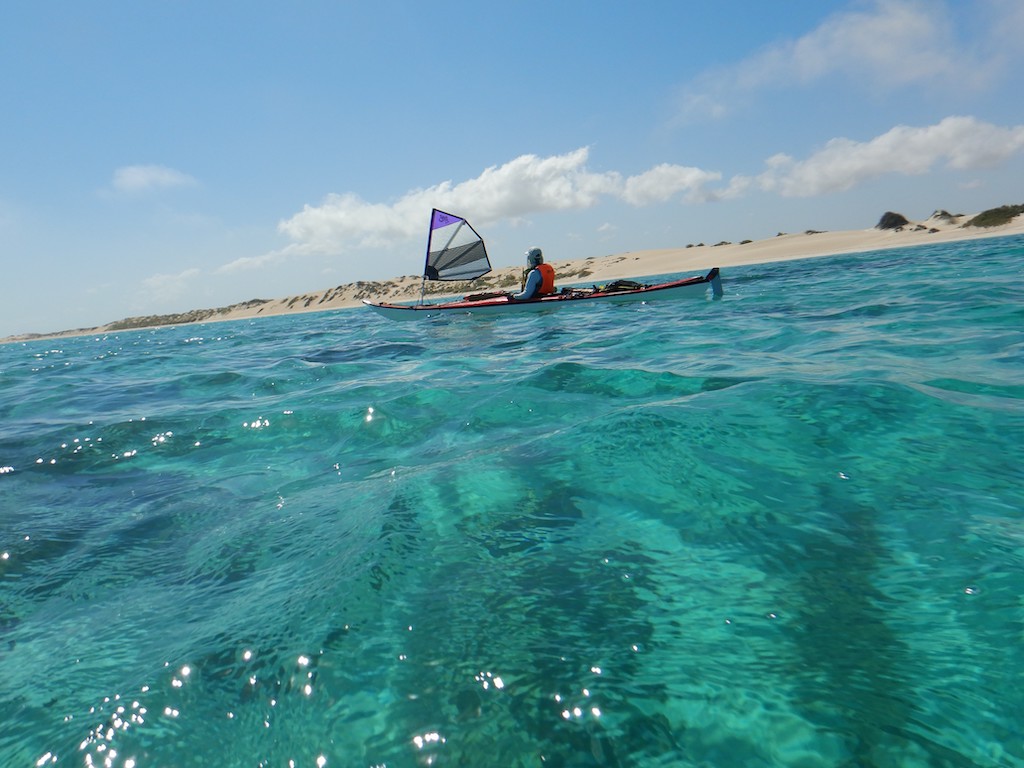
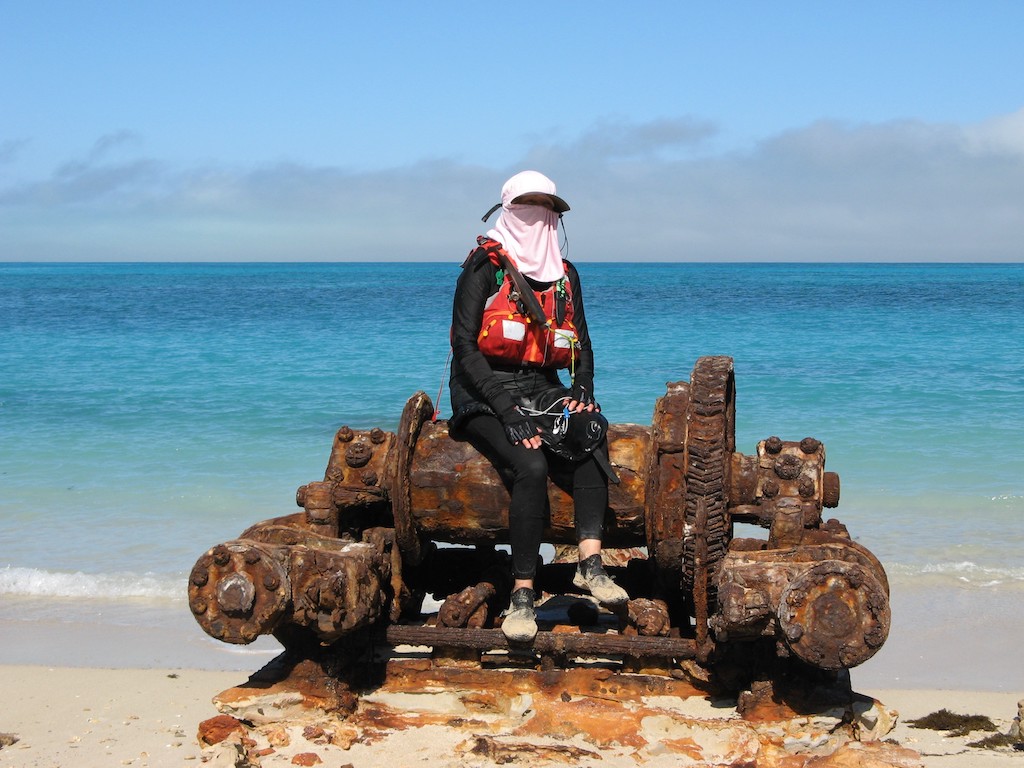
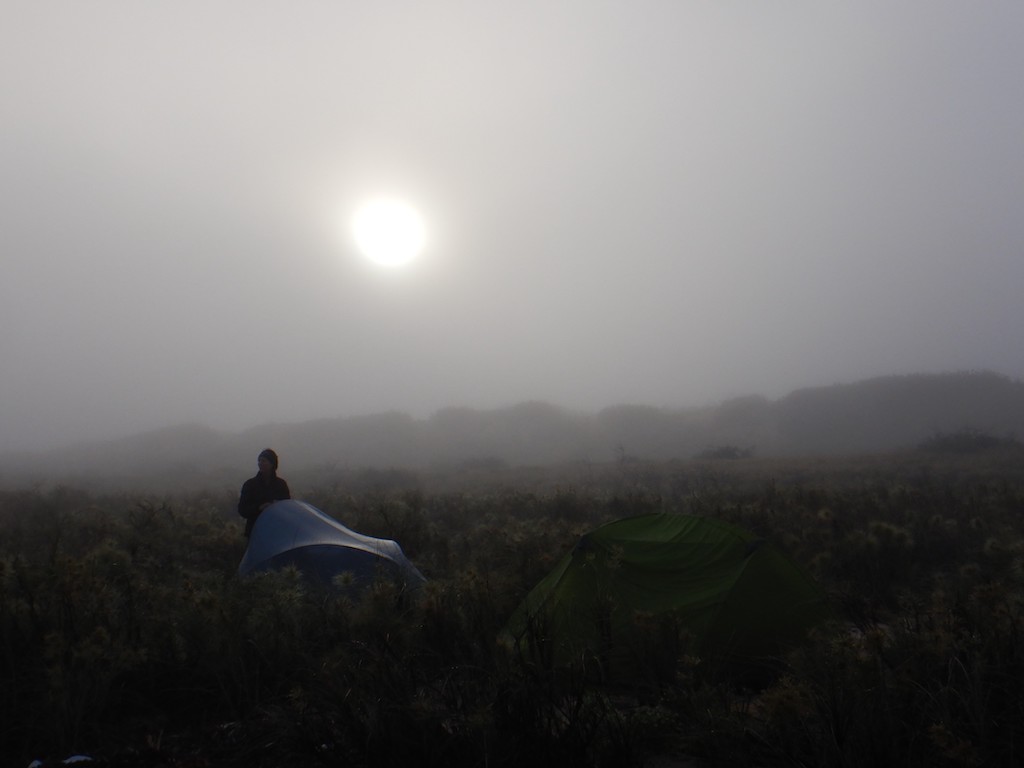
Day 5 (26/8/21) 16km
There was no dew this morning due to the 16 – 17 knot SSE winds. We were packing up our kayaks when I heard Jill say “Is that my Ikea bag or yours Jo?’ as I looked up to see my bag flying off toward Winderbandie Point. Jill and Colin thought it was quite hilarious watching me sprint down the beach chasing it and every time I neared it, it flew off further down the beach. I was well and truly stuffed when I got back to the boat. We left the beach with quartering winds until we rounded the point which Jill and I took sharply then paddling into a fresh headwind toward the shore trying to find some shelter from the wind. Colin however just continued further out at sea paddling from point to point. Later we met up and then as we turned a bend put our sails up for a fun cruisy sail. In the distance we could see breaking waves due to a large gap in the reef and coincidentally when we reached this area the wind had changed to SW, or at least a strong southerly, and the sail became very exciting from then on! Jill commented on my nervous giggle she would hear from time to time. It certainly was the most challenging sailing I have done in the kayak, and it was exhilarating and at times a little scary for me. Having the kayak loaded made a world of difference with the kayak feeling extremely stable even in the rough conditions. Rounding Sandy Cape, we were back in the protection of the reef with only small, confused waves. We started looking for a suitable camp for the night and after 3 stops we found a perfect bay sheltered from the 20 knot SW. Unfortunately some 4WDs were parked on shore, so we had to set up camp a little further down the beach, still lovely but quite windy. As usual we saw many turtles today along with a ray, dolphins, Osprey and Colin came across a snake in the dunes.
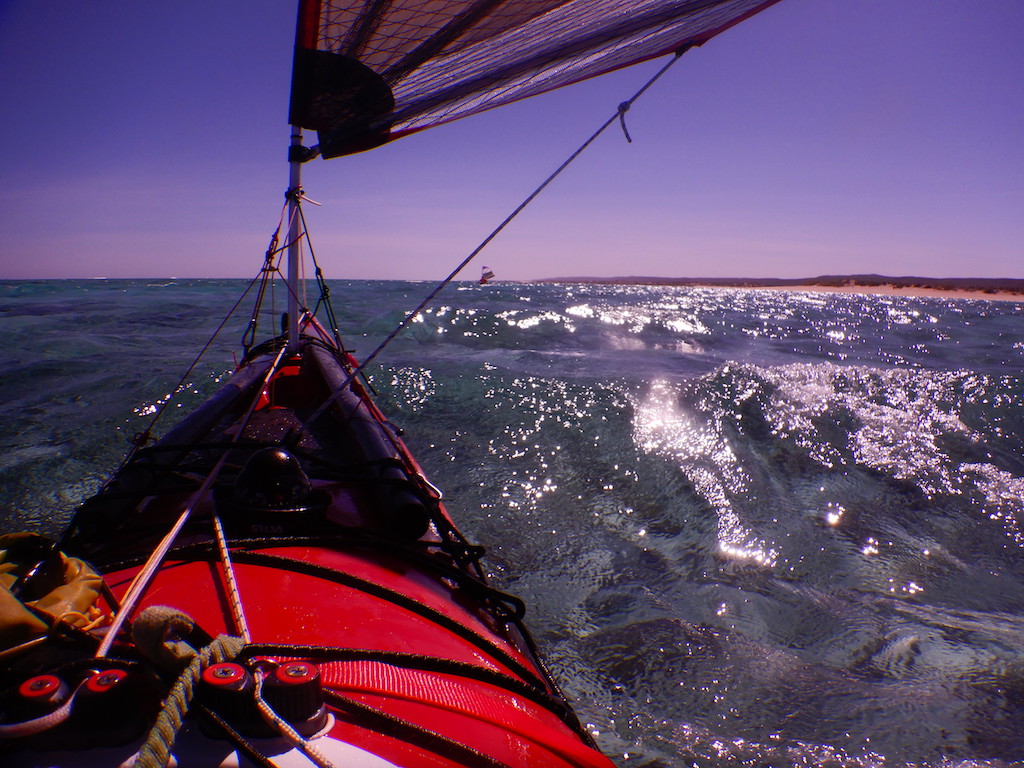
Day 6 (27/8/21) 13.5km
Waking to another day of 15 – 20 knot SE winds we had a nice run down to boat harbour camp. We were needing to get to One K camp (1km south of Yardie Creek) as we had 2 nights booked and Gail was planning to drive up and meet us there. The conditions deteriorated after that due to the very shallow water. With breaking waves and opposing wind chop ahead we decided to paddle at least a km from shore and picked our way through them. All along the shore was a rocky shelf so on seeing a sandy coastline ahead we made for that. As usual Colin was paddling at a cracking pace ahead of us, further spurred on by the fact he was meeting up with Gail this morning. We radioed him when he was near the beach asking if that was One K camp but got the negative that it was in fact Yardie Creek! As Jill and I started heading in closer to the coast we spied the long drop loo of One K camp. There was absolutely no way we could land our kayaks there due to the raised rocky shelf all along that area. When we got to Yardie Creek we went to see the campground host in the hope that maybe there would be a campsite available there for 2 nights or that national parks could perhaps suggest an alternative camp site we could access with our kayaks. The campground host went above and beyond her volunteer position, we only wish national parks had done the same. The person on the other end of the radio pretty much said it was our fault for booking the spot and we should have known it was 4WD access. We tried to explain that we were in kayaks and that the website makes no mention of the rocky shelf along the beach, and she was like “there must be a lagoon somewhere near there where you can land!”. We decided our predicament was falling on deaf ears and although commercial kayak operators are catered for, the same is not true for other kayakers. Fortunately, Gail turned up with the Troopy not long after (thankfully there had been no lockdown in Perth) and saved the day! Although Yardie Creek was open to the ocean it was crossable so we paddled up into Yardie Creek to unload everything into the troopy and then paddled back out to the ocean landing the kayaks and dragging them up into the sand dunes where we hoped they would be safe for the next 2 days. We all piled into the troopy and headed to the camp site, my least favourite camp of the trip, full of bulldust which was so fine that during the night the strong winds caused it to blow into my eyes and to cover my sleeping bag. The only positive was that the rocks were a good place to watch the sunset and to drink Jill’s warm white wine which had been in the car for the last 6 days!
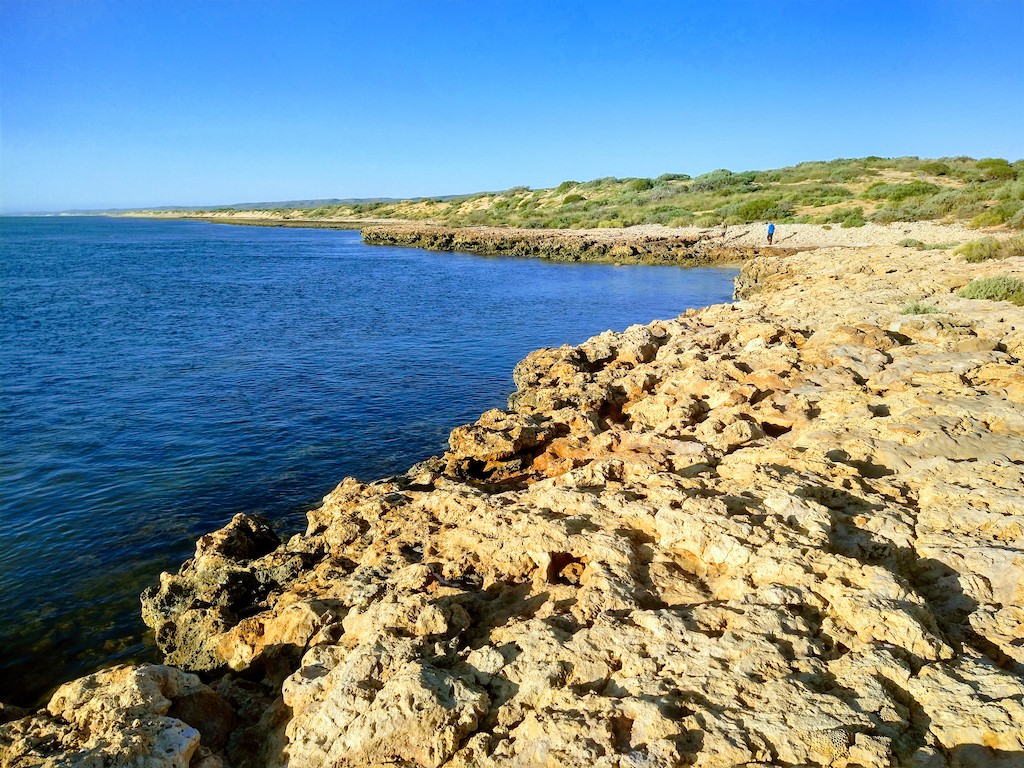
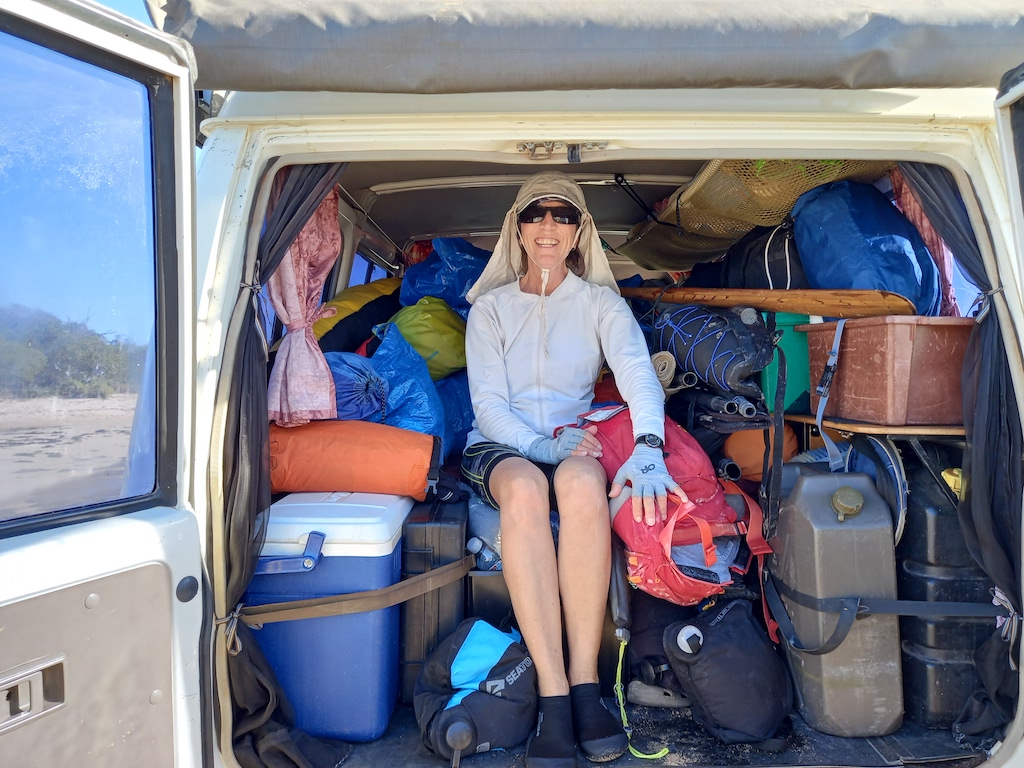
Day 7 (28/8/21) No paddling
We awoke to a bloke asking if we were the kayaking mob. At first I thought it was the Ranger until he mentioned Jill by name. From within her tent Jill says “that sounds like Ranger Bruce!”. Her hubby had tracked us down to say hi and he spent the day with Jill and Gail hiking up Yardie Creek (Jill also paddled up it) and treating us with fresh food and even a beer and G&T! Colin and I spent about 6 hours driving to Coral Bay retrieving my car and then dropping it off at Neds Camp further north in Cape Range National Park.
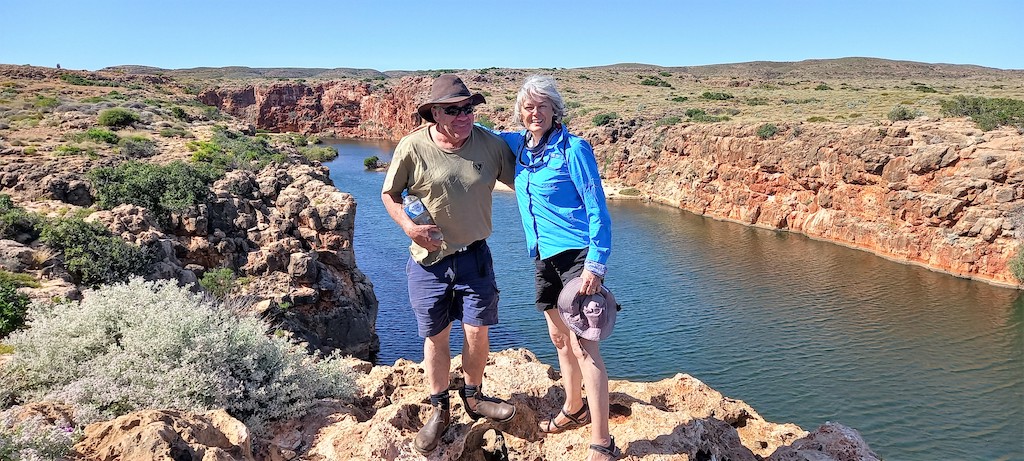
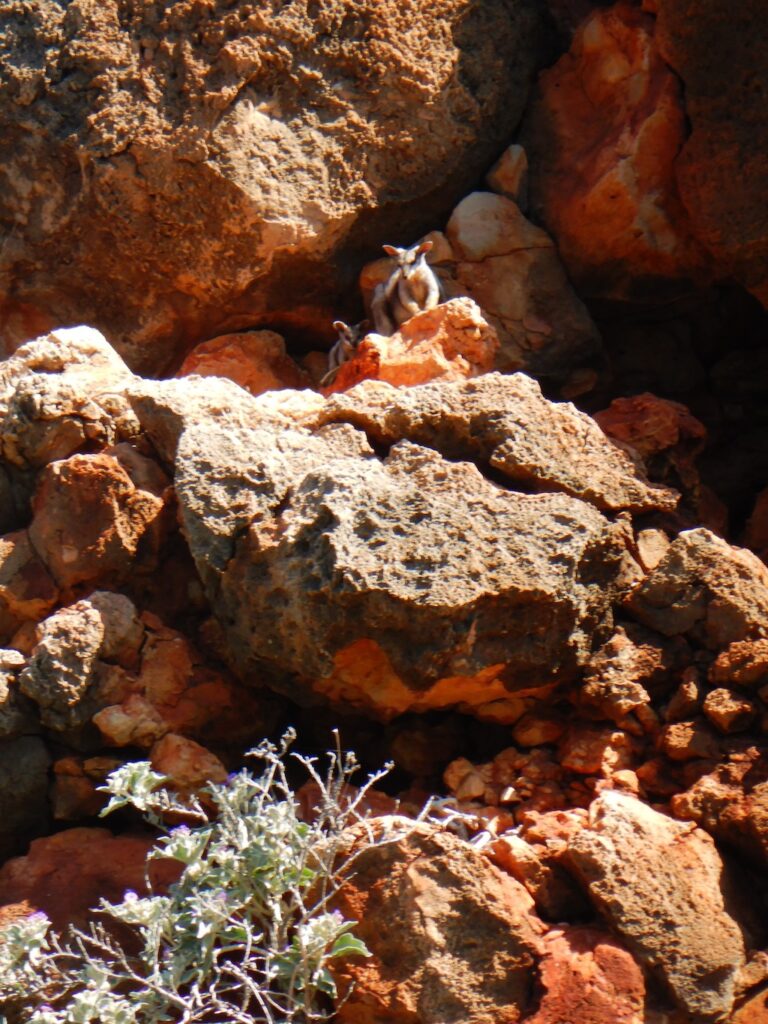
Day 8 (29/8/21) 11km
After shuttling all our gear back to Yardie Creek in the troopy and the long haul down to the kayaks we set off for Osprey Camp. It was a cruisy day, sailing for part of the journey with 10 – 15 knot S then SW winds. We startled many turtles along the way. Osprey camp has a beautiful bay and has many campsites (spaced out nicely). We found our booked campsite with Gail all set up reading a book under the awning of the Troopy. The sites are great for caravans or camper trailers but not ideal for tents as the solid ground makes it difficult to get your tent pegs in. Fortunately, Colin had special pegs and a hammer in the troopy he could share with us. After lunch we had a pleasant snorkel right out front of the camp. The highlight for me was being able to follow a large green turtle for ages while he was munching on the sea grass, surfacing each time he did. He was totally unphased by my presence which in my experience is unusual. We had a lovely walk over to Sandy Bay early evening and after dinner Sandy Robson surprised us by turning up to see us. I think she heard us before she saw us 😉

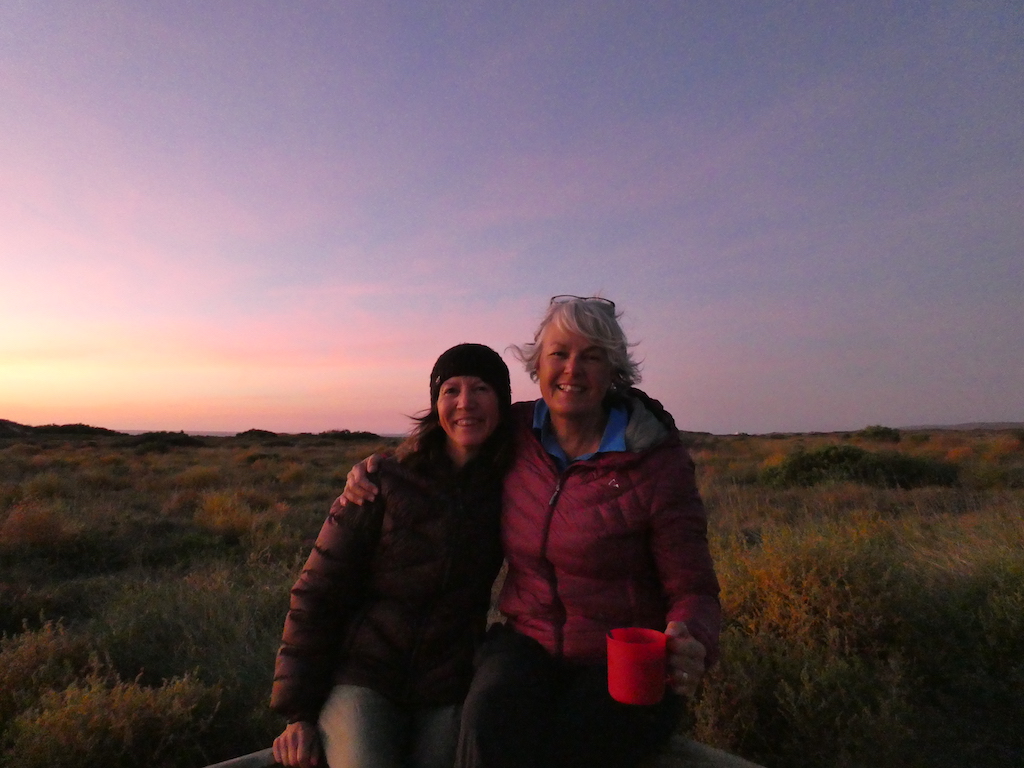
Day 9 (30/8/21) 14km
We started our day with a 1.1km paddle to a kayak mooring on the inside of the reef where we tied up our kayaks and jumped overboard for a snorkel. It was low tide, so we had to snorkel around some of the stunning plate and staghorn coral so as not to disturb it. We were spoilt with plenty of reef fish, a flounder hiding in the sand, cuttlefish, sea snake, blue spotted ray and lots more. By the time we got back into our kayaks the south westerly wind had picked up to 15 – 20 knots which it remained for the rest of the day. We sailed over to Sandy Bay and were there in a flash. We paddled then sailed passing Pilgramunna (which looked good for snorkelling but as there was a tour group there) and continued to South Kurrajong Camp which had a good sandy beach to land the kayak and have lunch. After passing Bloodwood Creek we paddled over reef which I imagine would be nice for snorkelling. We were booked to camp at North Mandu camp but it was a beach of large pebbles, so we took our chances and paddled on looking for somewhere without a rocky landing to camp for the night. There was just a high enough tide to paddle past Oyster Stacks without having to go out through the gap in the reef. Our camp was not ideal and no matter where we were we could not get out of the wind blasting sand, even later that night when the wind turned south easterly and Jill’s tent fly blew off. Colin felt the wrath of the wind also when he found his tarp was missing, luckily to be found later some distance away.
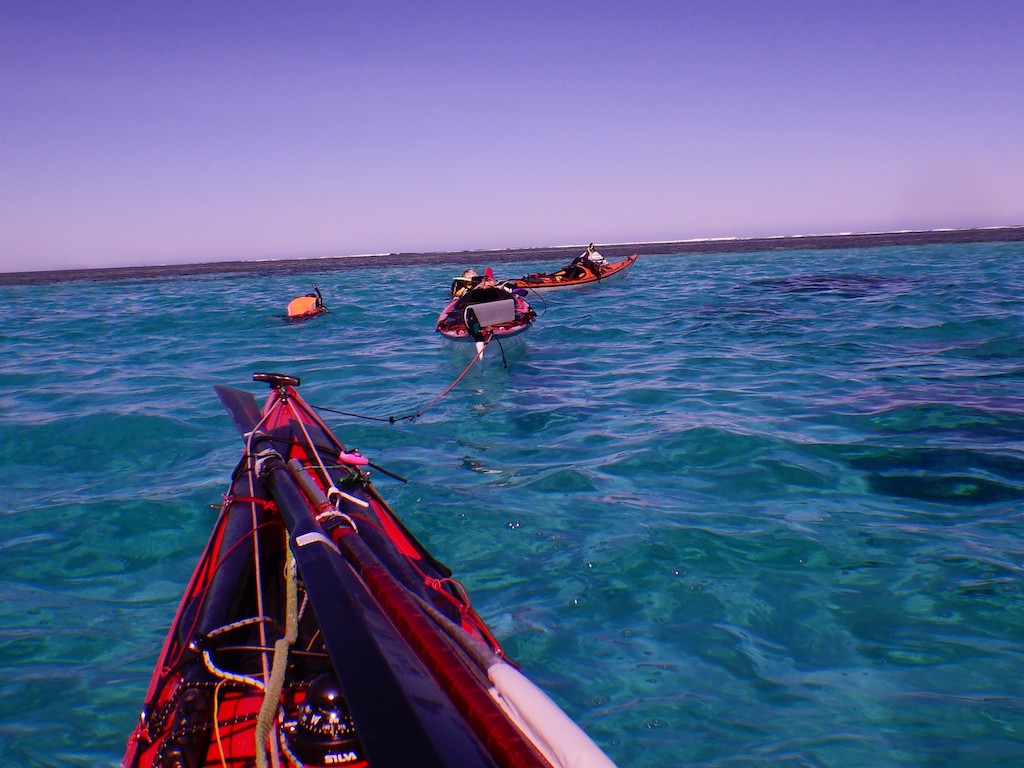
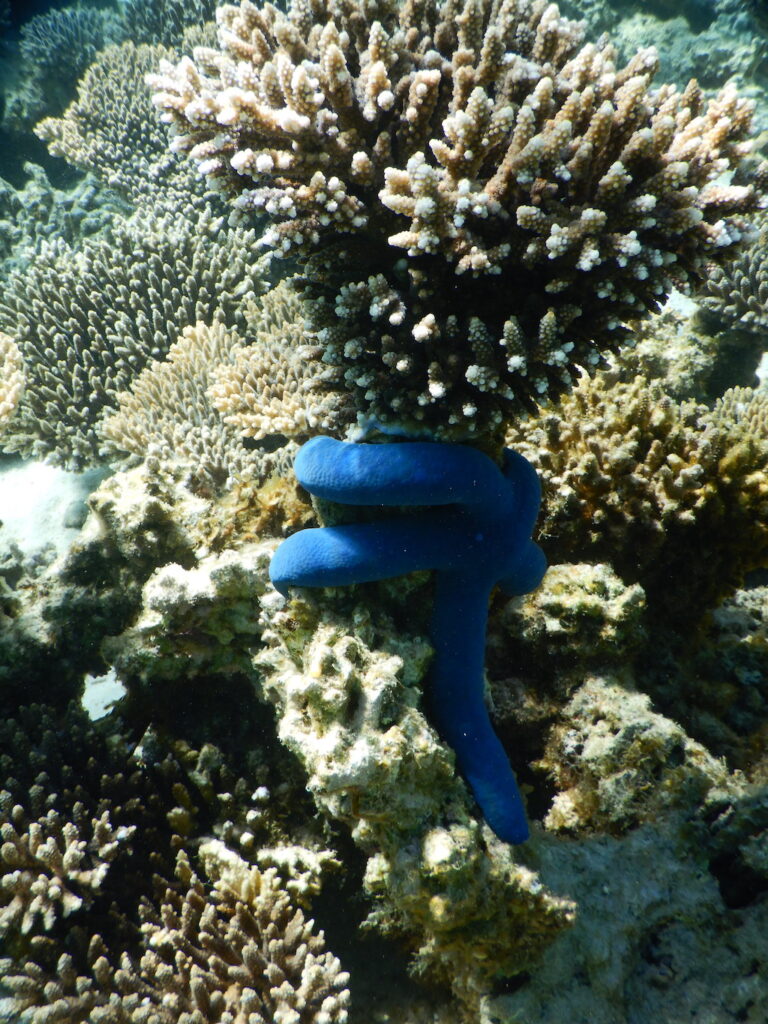
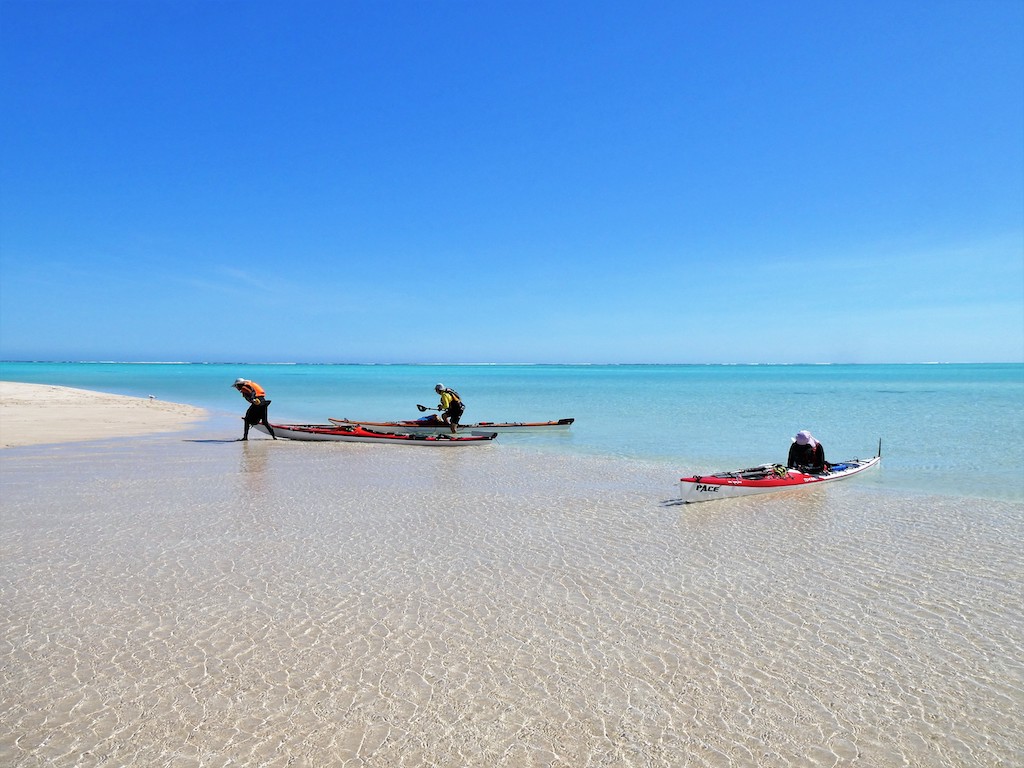
Day 10 (31/8/21) 14kms
After a night of excessive tent flapping (except for Colin who decided to forgo his tent outer for a more peaceful night’s sleep) we got up early to pack up our tents and kayaks surreptitiously. It was still a strong south easterly and way too cold to consider snorkelling, so we whiled away some time until we heard a “Cooee!” from Sandy who had managed to track us down. After much deliberation we decided to have a snorkel at Turquoise Bay. We headed out to the staghorn gardens and were again spoilt with a kaleidoscope of corals and fish, the highlights being unicorn fish and a blue spotted ray munching down and then trying to hide its feed from the fish surrounding it. We all left the water at a similar time as we were freezing so jumped in the kayaks and paddled on to Lakeside Bombies trying to warm up. After warming up in a sheltered spot where we ate lunch, we followed Sandy out to the bombies for a snorkel, and then through the channel between them, swimming against the current. We were rewarded with a huge potato cod, white tipped reef shark under a ledge, turtles and clown fish. It was a quick paddle with following seas to Ned’s camp where we surprised Gail by turning up a day early. We were worried we might be shattering her serenity but she seemed happy to see us. Good job we had that campsite booked as well as Tulki, so we had a choice. We were stoked to be setting up the tents for 2 nights and not having to pack it all up again next morning.
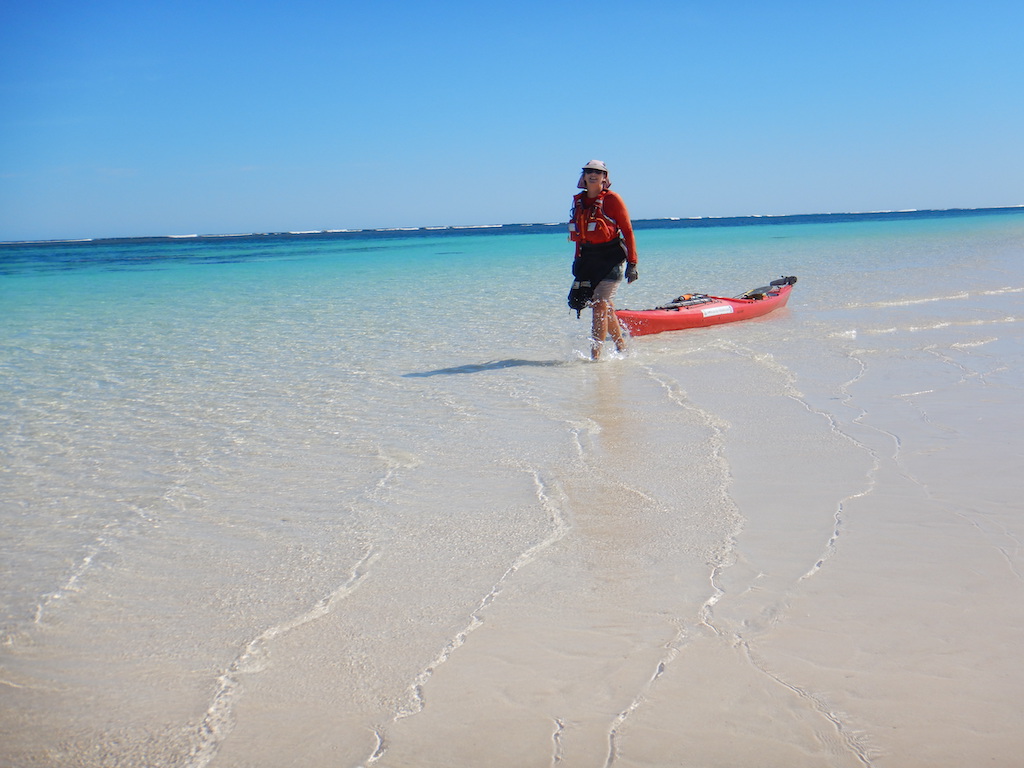
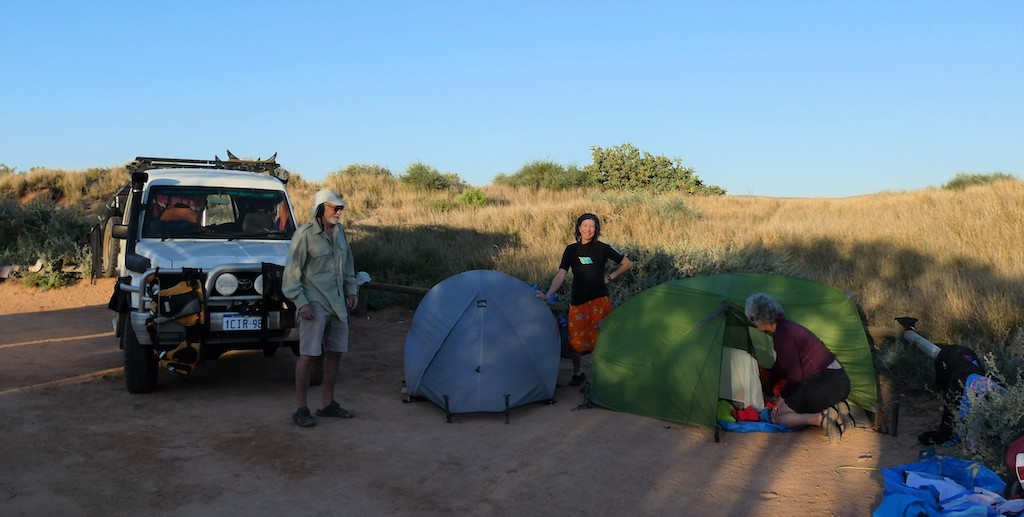
Day 11 (1/9/21) 12km
It was an overcast day with a nice 10 – 15knot SE so we paddle sailed northwards startling turtles and rays until we reached the Mangrove area. We dropped our sails with the idea of getting closer to shore, hoping to see a nursery of sharks or rays as I had seen on another trip. The tide however had other ideas, being way too shallow. We picked our way through the shallow rocks until we were able to get out to deeper water and sailed off again until we were approaching Tantabiddi. We went in search of the kayak moorings to snorkel, but the SW wind was picking up now, with wind chop and grey skies so we decided it wasn’t that appealing. As we were heading in toward the boat ramp, we caught up with Sandy who was just paddling out. She continued southwards for a fitness paddle. There were high fives all around as we landed at the south side of the boat ramp with mixed feelings about the end of our paddle expedition. Gail timed it perfectly turning up with the troopy to run me back to Ned’s to pick up my car. Gail really was an amazing support to us on the latter half of the trip although she would have preferred to have been paddling with us. When Sandy got back to Tantabiddi we all headed off to Yardie Homestead to buy lunch but found the café closed. Lucky for us Sandy had brought us carrot cake which filled us up instead – yum! We called in at Mangrove Bay bird hide which was very peaceful then returned to Ned’s camp. Colin tried his hand at fishing to no avail. It was the one and only time the fishing rods came out. I was very disappointed as Jill and Colin had promised me fish for dinner every night! It was a windy evening but we braved the bench in the sand dune where we had port and wine sunset drinks to celebrate the paddle end.
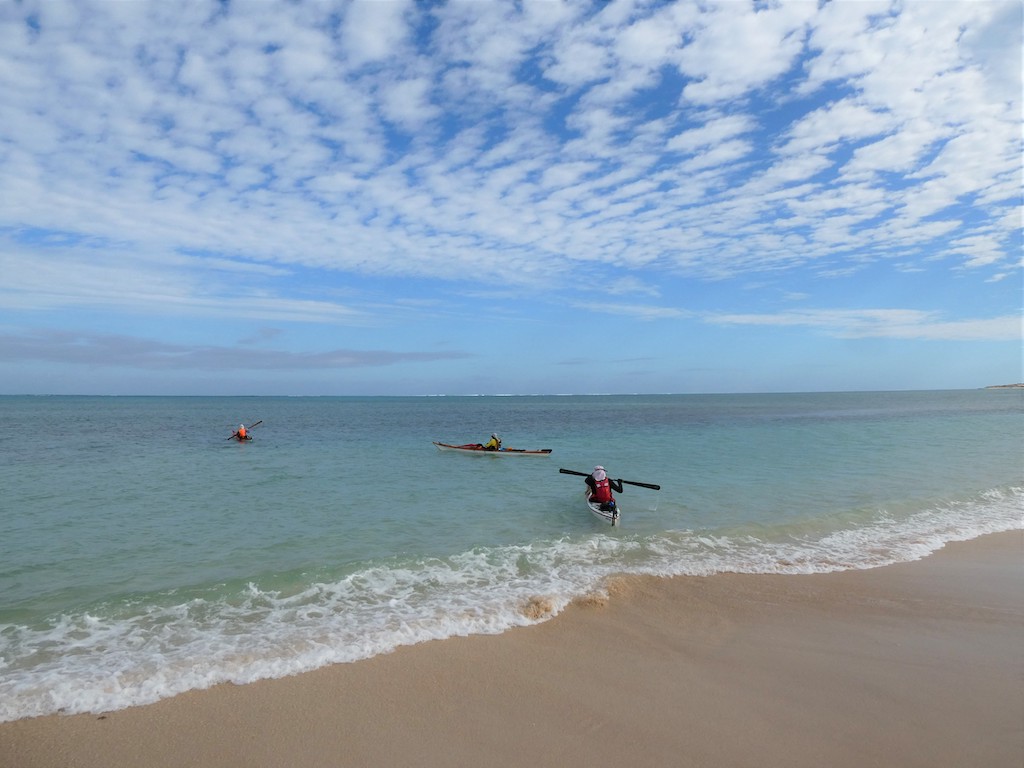
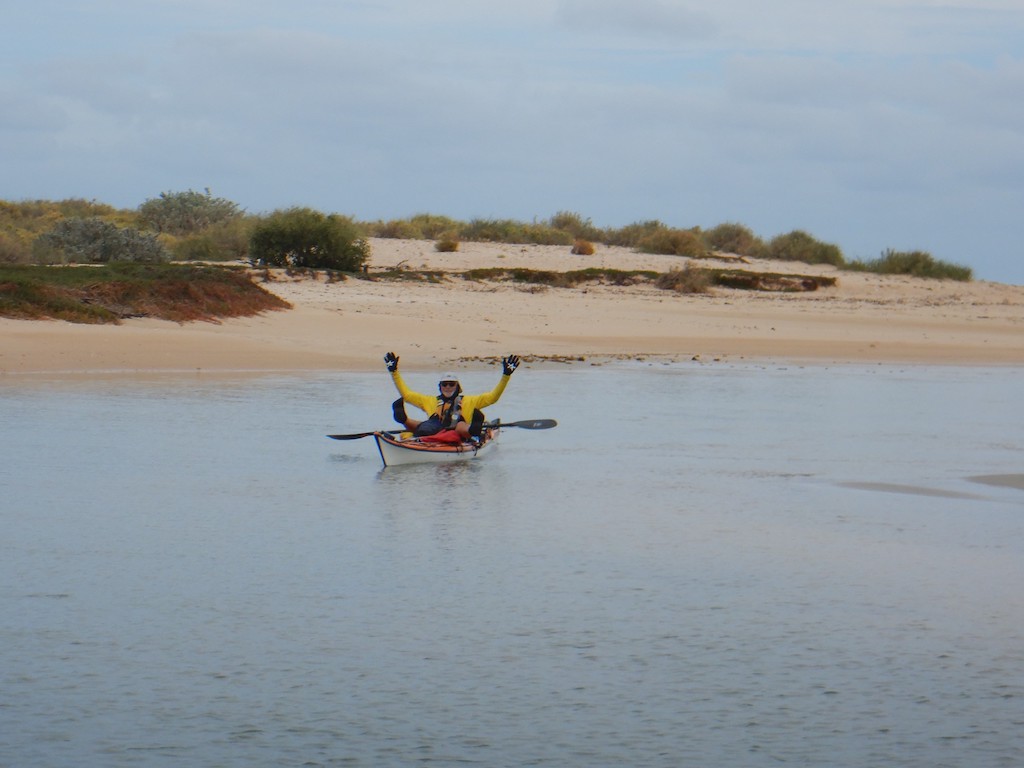
Day 12 (2/9/21) 0km
We were pleased we had finished our trip a day earlier than planned as the wind was even stronger today (SE 20+ knots). After packing up camp and our cars Gail and Colin went to Lakeside so Gail could get amongst the great coral and fish life there. Jill and I enjoyed the Mandu Mandu gorge loop walk through a dry white stone riverbed surrounded by ancient red cliffs, where we spotted a lone black flanked wallaby hiding in a crevice. The return walk took us over the top of the gorge where wedgetail eagles were soaring on thermals and great coastal views giving us a perspective of parts of our paddle expedition. I then decided to play tour guide, taking Jill down every road possible heading toward Exmouth. We checked out Woribi, the Lighthouse, The Dunes (surf spot), Mildura Wreck then shared a delightful Nasi Goring at Bundegi Beach (still a chilly SE wind which was onshore there). We reunited with Gail and Colin at the campground where we had a real bed for the night in a chalet and then had a farewell dinner and lots of laughs at the pub meeting up with Sandy.
Special thanks need to go to Colin for his diligent planning and all the work he put into the extensive Management Plan and to Jill and Gail for all you did too!
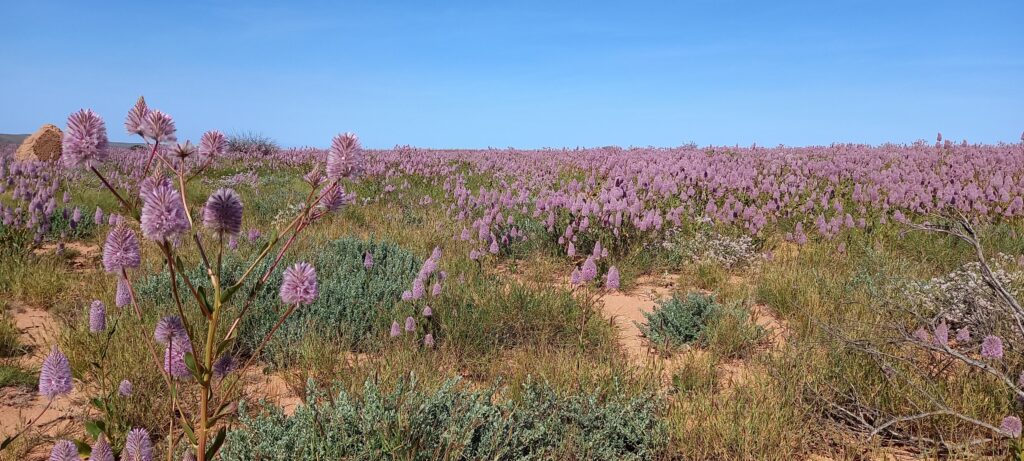
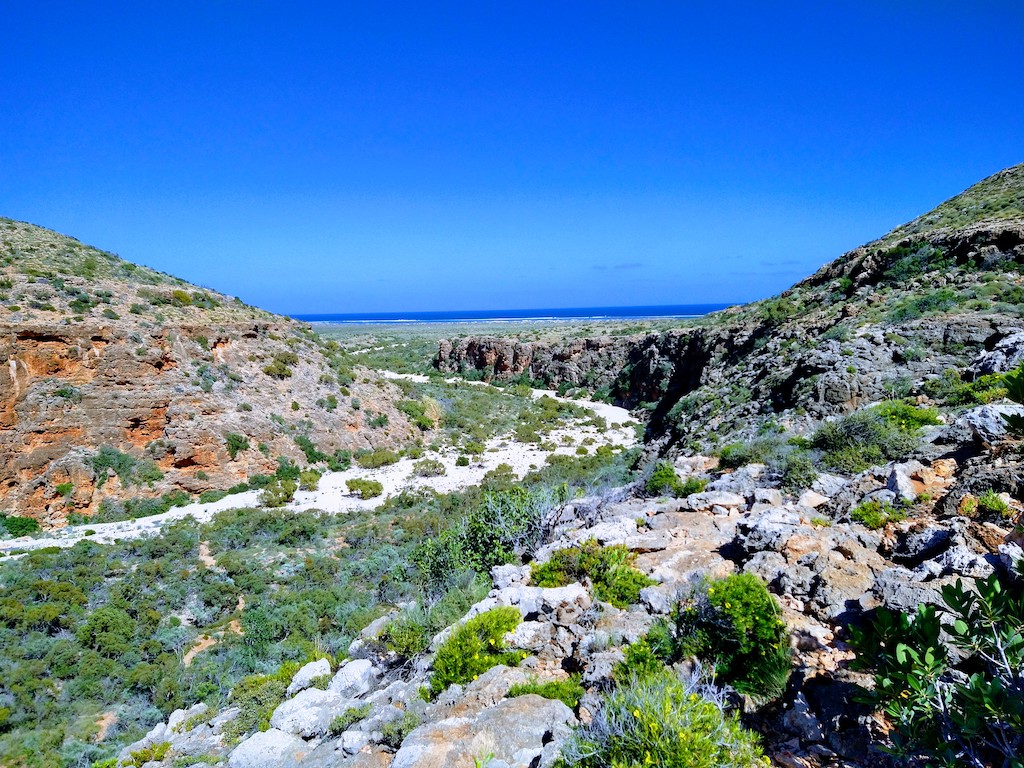
A suggestion for a cruisy shorter expedition for ISSA paddlers would be to start at Yardie Creek after leaving a car at either Ned’s camp (we paid for 1 person camping for the number of nights we left the car) or Yardie Homestead (they wanted payment too). You could have a really cruisy trip, allowing plenty of time for snorkelling and exploring if you camped at Osprey Bay, Kurrajong and Ned’s camp (all accessible by kayak), continuing up to Tantabiddi boat ramp. You could spend additional nights at one of the camps so that you have time to walk some of the gorges etc. Colin, Jill and I are happy to pass on any additional information you may require for either the whole trip or part of.
Trip reports
General information

Club constitution (PDF file, 530 kb)
Facebook Pages
- Sea Kayak Club WA (closed group)
- Albany group
Committee
President
Tony Bes
Secretary
Shantha David
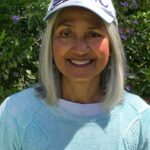
Vice President
Vacant
Treasurer
Mark Stallbaum

Program Coordinator
TBA
Committee Members
Steve Haddon, Damon Haddon & Pip Darvall.
SKCWA Magazine
WA Seakayaker, Aug 2019 26 MB PDF file download
WA Seakayaker, April 2019 26 MB PDF file download
WA Seakayaker, Nov 2018 14MB PDF file download
WA Seakayaker, June 2018 14MB PDF file download
WA Seakayaker, July 2017 4.4MB PDF file download
WA Seakayaker, Feb 2017 7.3MB PDF file download
WA Seakayaker, Nov 2016 7.5MB PDF file download
WA Seakayaker, Jun 2016 7.1MB PDF file download
WA Seakayaker, Mar 2016 8.5MB PDF file download
WA Seakayaker, Dec 2015 7.2MB PDF file download
WA Seakayaker, Sep 2015 2.4MB PDF file download
Archived Issues 1997 – 2008
Issue 71, July 2008 2.8MB PDF file download
Issue 70, April 2008 3.1MB PDF file download
Issue 69, February 2008 1.0MB PDF file download
Issue 68, November 2007 2.1MB PDF file download
Issue 67, August 2007 3.6MB PDF file download
Issue 66, June 2007 1.5MB PDF file download
Issue 65, Mar/Apr 2007 1.4MB PDF file download
Issue 64, Jan/Feb 2007 1.8MB PDF file download
Issue 63, Nov/Dec 2006 1.8MB PDF file download
Issue 62, Sep/Oct 2006 2.1MB PDF file download
Issue 61, Jul/Aug 2006 2.4MB PDF file download
Issue 60, May/Jun 2006 2.4MB PDF file download
Issue 59, Mar/Apr 2006 2.5MB PDF file download
Issue 58, Jan/Feb 2006 2.3MB PDF file download
Issue 57, Nov/Dec 2005 1.5MB PDF file download
Issue 56, Sep/Oct 2005 3.5MB PDF file download
Issue 55, Jul/Aug 2005 1.7MB PDF file download
Issue 54, May/Jun 2005 2.4MB PDF file download
Issue 53, Mar/Apr 2005 2.7MB PDF file download
Issue 52, Jan/Feb 2005 2.7MB PDF file download
Issue 51, Nov/Dec 2004 2.0MB PDF file download
Issue 50, Sep/Oct 2004 2.1MB PDF file download
Issue 49, Jul/Aug 2004 2.9MB PDF file download
Issue 48, May/Jun 2004 2.2MB PDF file download
Issue 47, Mar/Apr 2004 2.6MB PDF file download
Issue 46, Jan/Feb 2004 3.6MB PDF file download
Issue 45, Nov/Dec 2003 3.2MB PDF file download
Issue 44, Sep/Oct 2003 2.6MB PDF file download
Issue 43, Jul/Aug 2003 3.6MB PDF file download
Issue 42, May/Jun 2003 2.9MB PDF file download
Issue 41, Mar/Apr 2003 3.7MB PDF file download
Issue 40, Jan/Feb 2003 2.3MB PDF file download
Issue 39, Nov/Dec 2002 3.0MB PDF file download
Issue 38, Sep/Oct 2002 3.6MB PDF file download
Issue 37, Jul/Aug 2002 2.7MB PDF file download
Issue 36, May/Jun 2002 3.4MB PDF file download
Issue 35, Mar/Apr 2002 2.8MB PDF file download
Issue 34, Jan/Feb 2002 2.9MB PDF file download
Issue 33, Nov/Dec 2001 3.0MB PDF file download
Issue 32, Sept/Oct 2001 3.3MB PDF file download
Issue 31, July-August 2001 3.0MB PDF file download
Issue 30, May-June 2001 1.5MB PDF file download
Issue 29, Feb 2001 740KB PDF file download
Issue 28, Dec 2000 1.7MB PDF file download
Issue 27, August 2000 1.3MB PDF file download
Issue 26, June 2000 4.9MB PDF file download
Issue 25, April 2000 2.2MB PDF file download
Issue 24, February 2000 1.4MB PDF file download
Issue 23, Dec/Feb 1999-2000 2.8MB PDF file download
Issue 22, Oct/Nov 1999 1.3MB PDF file download
Issue 21, Aug/Sep 1999 2.5MB PDF file download
Issue 20, Jun/Jul 1999 2.6MB PDF file download
Issue 19, Feb/Mar 1999 4.6MB PDF file download
Issue 14, Dec/Jan 1998-9 4.8MB PDF file download
Issue 13, Oct/Nov 1998 1.8MB PDF file download
Issue 12, Aug/Sep 1998 1.6MB PDF file download
Issue 11, Jun/Jul 1998 2.1MB PDF file download
Issue 10, May 1998 690KB PDF file download
Issue 9, Mar/Apr 1998 1.2MB PDF file download
Issue 8, Jan/Feb 1998 1.3MB PDF file download
Issue 7, Oct/Nov 1997 1MB PDF file download
Issue 6, September 1997 2MB PDF file download
Issue 5, July 1997 1.1MB PDF file download
Issue 4, June 1997 376KB PDF file download
Issue 3, May 1997 1.1MB PDF file download
Issue 2, April 1997 253KB PDF file download
Issue 1, April 1997 438KB PDF file download
Note: due to a numbering error, issues 15-18 do not exist.
Policies and Strategies
SKCWA and the members of the club are bound through their membership to the policies of Paddle Australia.
The full list of Paddle Australia policies can be found here.
Risk Management Strategy (PDF, 110kb)
Other important documents are:
Club constitution (PDF, 81kb)
COVID-19 Management Plan (June 15, 2020, 2.2Mb)
Sea Instructor Qualification Payment Policy (March 13, 2024, MS Word, 22kb)
Information for members
Please refer to the ‘For Members’ submenu.
Paddle around Francois Peron – Shark Bay, September 2021
Trip Report by Sean Sinclair
September 2021
When I saw the Shark Bay expedition being advertised, I could not wait to get on board. The opportunity to do an expedition around Cape Peron does not come by that often. So when Pel and Bruce confirmed I would be able to join in, I was quite excited. So I cut short an already planned camping trip by a day or two and got myself organised. Dry bags, light weight hiking equipment, meal plan and gear. I had a quick dry run of packing it all in the kayak to make sure it would fit, and deciding what went where.
I left home Saturday and met Pel in Northampton. We had only met briefly once before, and it was a good opportunity to get to know each other over a beer and a meal. The next day we went on to Denham, where we scouted out the Monkey Mia landing and car park situation. We then checked into the chalet at Denham Seaside and got our kit in order as the rest of team started to arrive. Dylan, Austen and then Kim and Bruce. Being a south of river paddler, I had not met nor paddled with any of these guys before. So after a few how-do-you-dos and what do-you-dos, we got down to business. It was decided we would start the next morning, with prevailing winds being a big factor in that decision.
The first day was a bit of a late start as we had to organise the cars to the take out point, which was a 50 km round trip. It was around 10 before we got under way. The wind was in our favour, but the tide was going out literally before our eyes. The witty banter between comrades soon went quiet as the crew focussed on packing their gear. We needed to carry everything. Food, water and equipment for 6 days. 5 planned and 1 spare if needed. This meant about 4 litres of water per day and about a kilo of food (when reconstituted). All up around 30kgs of consumables plus another 15kgs of camping and safety equipment. Therefore fitting it all in required careful thought for placement and accessibility.
I had no idea regarding the extent of the shallows around this cape. I had not even given it any consideration. Low tides would prove to be almost as big an issue as wind. With the tide dropping, it flows across the shallows, and they extend to the horizon. The more we committed to paddling inshore, the more we ran the risk of running out of water if we took too long.


For the most part of the first day, we paddled through water that varied in depth from 1 meter to as little as 20cm. We spent a lot of time manoeuvring to find deeper parts. We had a strengthening breeze at our backs, and were making excellent progress. We beached for a quick lunch break, displacing many small sharks in the shallows, before heading on to Big Lagoon for our first camp.
Big Lagoon and its turquoise blue entrance is quite spectacular. After drifting over the last few hundred metres of shallow rocky reef, the crystal clear waters and initially grassless sandy bottom were a sight to behold. A few Rays and Turtles were spotted quite close by as the water way drew us into the lagoon where we sought a suitable camp site for our first night. Ample bird life was also to be seen resting on the tidal sand bars. During the latter part of our day, and inside Big Lagoon, we witnessed on many occasions fish leaping out of the water. This activity continued right in front of our camp site. With the sun setting behind us as we looked out over the waters, brilliant flashes of silver kept on popping up out of nowhere. Some of these fish where a good 30-40cm long, so goodness knows what was chasing them.


Day Two
and up early for a big day to get right up the coast. If wind and tides were in our favour, we would try to make it to Bottle Bay camp site. This was the furthest of 4 options being approximately 32kms from Big Lagoon. Kim was our leader for the day. Rounding the red sandy headland we pushed north by northwest. Very soon it was apparent that our luck was in, and the wind was pushing us along quite nicely, and we were still in front of the falling tide. We paddled across the shallows spotting many of the usual sharks and rays. We tried to pick a beach for lunch but locations were not easy to find. So we ended up just pulling up on very slightly submerged sand bar where small sharks were scouring the sandy bottom in around 10 cm of water. Whilst we ate we were treated to a swim by of a magnificent shovelnose ray. It was about 1.5m long with its easily identifiable triple fin tail, diamond shaped body and eyes on top of its flat head. In other parts, similar species are often called guitar fish. Kim has a photo I think.
After about 20km of paddling over the shallows, we rounded Cape Lesueur and moved over some deeper open water. We revelled in the conditions, finally being able to open up the shoulders and run with some of the wind waves rolling through with the breeze. After a brief discussion on suitability of using the public camp ground we broke camp around 2pm. There was a little bit of kayak hauling required to get them nearer to camp, and out of the way of beach fisherman. The long drops were suitably utilised for their intended purpose, no worries there. Bruce and Pel arrived shortly after, after an adventurous day performing 4WD rescues, amongst other things
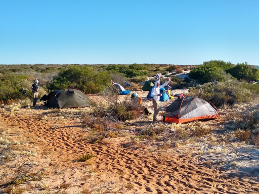
Day Three
would see us rounding Cape Peron early and then start our paddle south towards Herald Bight. The wind was now blowing from the west as the weather was starting to change. This was somewhat on our shoulder and not too much of a hindrance as we progressed south. This section was highlighted by vibrant red bluffs plunging down to white sandy beaches or turquoise seas. Many of these parts are not easily accessible. The scenery speaks of time, with oxidising and eroding on its surfaces happening every season. A sea kayak is the ultimate way to really get to see this.

Day 3 would also bear witness to ‘The Mishap’. Dylan had packed his ‘mocha pot’ so he could enjoy fresh brewed coffee along the way. We stopped for morning tea break and he quickly unpacked it and his gas stove to get a brew going. We could could hear it getting all steamed up and Dylan declaring it done, moving in to grab and pour, only to bump it off the stove and tip its wonderfully aromatic contents onto the sand. He said absolutely nothing, just cleaned up, packed up and paddled off. He did confess later to there being an absolute rage happening on the inside.

We made it to Herald Bight by lunch time. After a short discussion between mouthfuls, we decided that we would take advantage of the westerly wind and continue on east to camp on a small promontory that projected north from headland. This part featured white sands and mangroves seemingly unspoilt by people. The 5km paddle straight across the bay provided some large turtle sightings and our first Dugong sighting. I think Dylan spotted it first being almost directly over it. The Dugong swam straight towards Kims boat, before realising he was there. It then did a terrific turn about, flicking its tail in the air, and splashing Kim. What a great encounter for them. We were really quite happy with our decision to camp at this spot, and we were treated to a spectacular sunset as some clouds rolled in. There was some rain during the night as the tip of a cold front passed through.

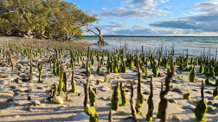
Day Four
Patchy skies greeted us as the sun broke first light, illuminating the tent walls, highlighting the beads of water on the fly cover. It was going to be a wet pack up for sure. As we paddled across the now flooded sand bar that was the absolute extension of promontory, there was a massive congregation of mostly Pied Cormorants on a sand island just in front of us. Kim asked us to pause so he could make a video of them. They were guaranteed to take flight as we drew near and he wished to capture it. There were literally thousands of birds all gathered, and as if on cue they all started to take flight. It was a mass exodus, with a cacophony of sound like you just can’t imagine. The beating of wings and pattering of webbed feet wildly kicking to assist with flight, in an orderly fashion of who’s first, hundreds at a time. You need to see Kim’s video to believe it. There were so many taking to the sky it was turning black as though there were swarms of these birds. Most birds relax their sphincter just before flight. It’s an old photographers tell. So you can just imagine the smell as we paddled past. The whole experience was sensory overload. Shortly after Dylan sighted another Dugong. So exciting.
After coming around the tip we heading face first into a stiff south-easterly breeze. So we proceeded to work around the first few bays, rather than paddle point to point between the headlands punching straight into the wind. This only worked for a while as the water was starting to get too shallow in close. We were due to make Cape Rose that day, rounding the subtle bend to make camp with Monkey Mia in sight. However the low tide prevented our traverse with the exposed sandbar not passable. We set up our last camp in the near by dunes with our kayaks lined up just above the high tide mark about 30 metres away. There was some concern about vehicles during the night due to the tyre tracks in the sand. There was some mobile reception available and many of us using the opportunity to check in with loved ones, burning up the few remaining percentages of battery we had left in our phones. My beach camp was characterised by a persistent pair of Pied Oyster Catchers that were a bit put out by our presence. They spent the afternoon and early morning curiously trying to sneak in and around the camp site.
In the wee small hours (it’s called that for a reason) I had just been for a quick excursion outside my tent and was just getting warm and comfy back inside, when I heard a vehicle. The sound was a loud groan of an older 4WD being tortured as it laboured through the soft sand. I stuck my head out and sure enough I could see the headlights coming around the corner. I stepped out to stop them. They pulled up in their black-rimmed dual cab Ute with a traditional greeting of ‘How ya going?’, followed by ‘we’ve been bogged for 4 hours ay!’ I asked them to watch out for our kayaks. Then it was as though I had Jedi Mind Trick powers. They simply repeated my words back to me. I said ‘it’s a dead end up there’ and they replied ‘it’s a dead end up there’. ‘You had better turn around’. ‘We had better turn around!’. And so they did, performing a wild clutch-drop and U-turn, rear tyre flapping on the rim where it had broken its bead. Off they went, never to be seen again.
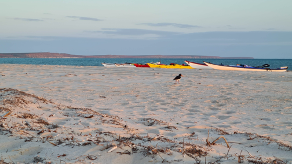
So the Final Day presented itself. We had paddled beyond expectation, achieving 5 day trip without somewhat arduous days, usually finishing by early afternoon. This gave plenty of time for rest and recuperation. However, we were not done yet and nor was the wind. Saving its best for last. Rounding Cape Rose we paddled straight into 20km/h headwind, gusting to 30, over relatively shallow water. The chop, spray and relentless gusts were very taxing to say the least. It wasn’t unexpected though. The reputation of these parts as being very windy is well known. Given that, we were already quite aware of how fortunate we had been with the weather so far. Three and a half great days over one and a half ordinary ones I’ll take anytime. After about 2 hours we had made around 5km, having to slug it out non-stop to avoid being pushed back to where we started. After a break on a beach we saddled up for the last push towards the finish at Monkey Mia. We were able come together as a group as we paddled past the jetty. Just as we did, the resort sent out three of its dolphins to escort us past the finish line, in some kind of aquatic guard of honour.
Overall, I thoroughly enjoyed myself. Being able to experience the Francois Peron NP from a sea kayak was such a unique and privileged opportunity. I really enjoy sea kayak paddling and I was able to relish in some of the conditions. Turning around to catch some waves and zig zagging my way, tacking into the wind, is always a lot of fun. My only injury was from the extremely saline water drying on my hands and paddle, and sanding my finger tips smooth. I can no longer unlock my phone using fingerprints.
I am very grateful to Bruce, Pel, Kim, Austen and Dylan for accepting me into their paddling group, particularly as an unknown. We should all be proud of our efforts and what we achieved.























